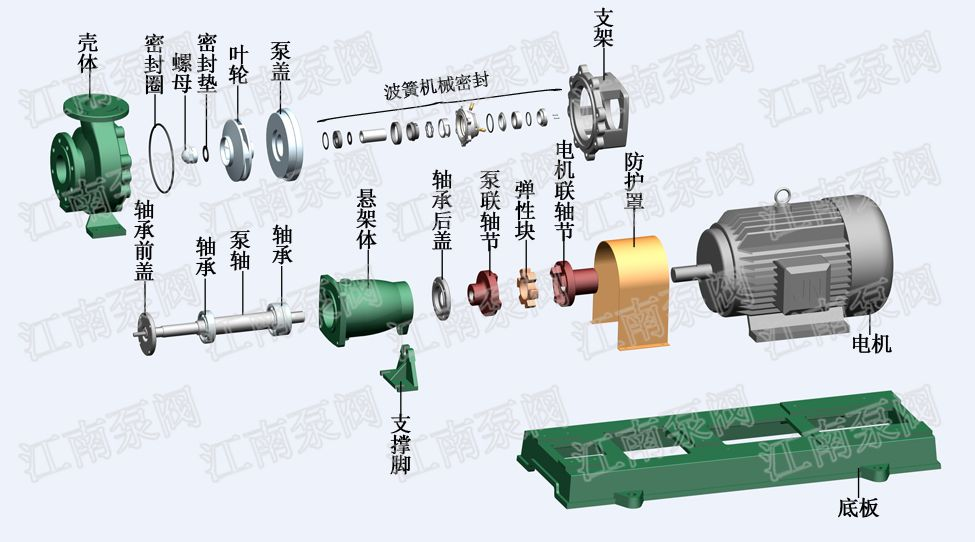Common Knowledge Q&A on Centrifugal Pump Maintenance
2023-04-03 From: Weihai Changtai Shipbuilding Company Browsing times:44
Common Knowledge Q&A on Centrifugal Pump Maintenance
1. What are the vulnerable parts of centrifugal pumps?
Answer: Bearings, shaft sleeves, impeller mouth rings, shell mouth rings, mechanical seal dynamic and static rings, sealing rings, coupling gaskets, etc.
2. Why is the outlet valve closed when starting a centrifugal pump?
Answer: Because when the flow rate of the centrifugal pump is zero, the power is small. This can reduce the starting current of the motor and protect it.
3. How are the rated flow rate, head, and power of centrifugal pumps specified?
Answer: The flow rate, head, and power at which the centrifugal pump has the highest efficiency are determined as the rated flow rate, head, and power of the centrifugal pump.
4. What are the consequences of cavitation in centrifugal pumps?
Answer: (1) Generate noise and vibration;
(2) Accompanied by a decrease in flow rate, head, efficiency, and even inability to operate;
(3) The impeller shell and blades have pitting and honeycomb like damage, which can even cause shell penetration;
(4) Causing damage to the pump shaft.
5. Does the flow rate change of a centrifugal pump generate radial force during normal operation?
Answer: It can generate radial force. Due to changes in flow rate, the pressure distribution around the impeller becomes uneven, resulting in radial forces acting on the impeller.
6. What are the hazards of radial force in centrifugal pumps
Answer: Because the radial force of the centrifugal pump acts vertically on the pump shaft, the pump shaft will have a large deflection (official account number: pump steward). The rotating shaft will be subjected to the force of alternating load, so the existence of the radial force will fatigue and damage the pump shaft.
7. What are the hazards of axial force in centrifugal pumps?
Answer: The presence of axial force in centrifugal pumps can cause wear on the mouth ring, balance plate, and impeller; Damage to mechanical seals, bearings, and motors.
8. What methods are used in the design of centrifugal pumps to eliminate axial force?
(1) Using balance holes, balance disks, balance tubes, and balance drums;
(2) Double suction impeller;
(3) Utilize thrust bearings;
(4) Utilize the symmetrical arrangement of impellers, etc.
9. What is the main reason for the centrifugal pump not being able to fill water?
(1) There is gas inside the pump inlet and inlet pipe;
(2) The increase in medium viscosity does not match the design;
(3) Leakage of inlet pipelines or mechanical seals;
(4) The inlet pipeline is blocked;
(5) The pump's rotational speed has not reached the rated speed;
(6) Pump reversal;
(7) The gap between the mouth rings is too large.
10. What are the main causes of vibration in centrifugal pumps?
(1) The coupling is not concentric;
(2) The bending degree of the shaft exceeds the standard;
(3) The bearing clearance is too large or damaged;
(4) Rotor imbalance;
(5) Friction occurs between the rotor and stator;
(6) The medium carries gas and has cavitation phenomenon;
(7) Pump evacuation;
(8) There are foreign objects in the impeller flow channel;
(9) Unreasonable installation of process pipelines has subjected the pump to external forces.
(10) Long term low load operation;
(11) The impact of vibration on auxiliary pipelines;
(12) The anchor bolts are loose.
11. What are the reasons for overheating of centrifugal pump bearings?
(1) Poor quality or wear during operation of rolling bearings;
(2) The clearance between sliding bearings is too small;
(3) Poor cooling of the bearing box;
(4) Insufficient or excessive lubricating oil or grease, or impurities.
12. How many reasons can cause excessive current in centrifugal pump motors?
(1) The medium density or viscosity is too high and does not match the design;
(2) Severe friction occurs between the rotor and the housing;
(3) The coupling is not concentric or the bearing is worn.
13. Which types of centrifugal pump rotors generally only require static balance for installation?
(1) Single stage pump;
(2) A multi-stage pump rotor with a smaller diameter;
(3) A rotor with lower rotational speed.
14. What types of centrifugal pump rotors are installed to find dynamic balance?
(1) There are many impellers;
(2) Larger diameter;
(3) A rotor with high rotational speed.
15. What are the methods for aligning couplings?
(1) Single table correction method;
(2) Double table correction method;
(3) Three tables to find the correct method.
16. What are the reasons for the unstable or significant fluctuation of the pressure gauge pointer at the outlet of the centrifugal pump?
(1) The pressure gauge is damaged and the indication is not working properly;
(2) Pump evacuation or flow fluctuation;
(3) There are impurities or blockages in the pipeline;
(4) Pump vibration;
(5) There is gas inside the pipeline or pump casing;
(6) Cavitation.
17. What are the effects of centrifugal pump evacuation on mechanical seals?
(1) Will cause significant leakage of mechanical seals;
(2) Damaging the sealing surface of the mechanical seal and even causing damage.
18. What is the allowable bending value for centrifugal pump shaft?
Neck: not greater than 0.02mm;
Mid axis:
(1) 1500 revolutions per minute not exceeding 0.08mm;
(2) 3000 revolutions per minute not exceeding 0.06mm.
19. What is the general requirement for the clearance between the centrifugal pump port rings (expressed in fractions)?
Answer: For pumps used at room temperature, it is advisable to take a diameter gap of 0.5mm when the diameter of the mouth ring is less than 100mm. If it is greater than 100mm, the gap should be 0.5+(D-100) × 0.002 (D is the diameter), and 0.1mm should be added at high temperatures.
20. What are the consequences of excessive or insufficient clearance between the impeller rings of a centrifugal pump?
(1) The clearance between the mouth ring is too large, causing the pump to fail and the efficiency to decrease;
(2) The gap between the mouth rings is too small, which can cause friction and even lead to shaft hugging.
What work should be done before debugging the centrifugal pump after maintenance?
(1) Refer to the maintenance work steps;
(2) Perform turning;
(3) Open the inlet valve and slightly open the outlet valve of the high-pressure pump;
(4) Open the vent valve;
(5) Start the pump and pay attention to the direction of rotation;
(6) After checking that the operation meets the requirements, it can be put into use.
What is the allowable working temperature for rolling bearings used in centrifugal pumps?
The API610 standard sets the upper temperature limit for bearing use at 93 ℃
What is the purpose of centrifugal pump disc drive?
Answer: Mainly to avoid bending deformation of the shaft due to its own weight or friction.




